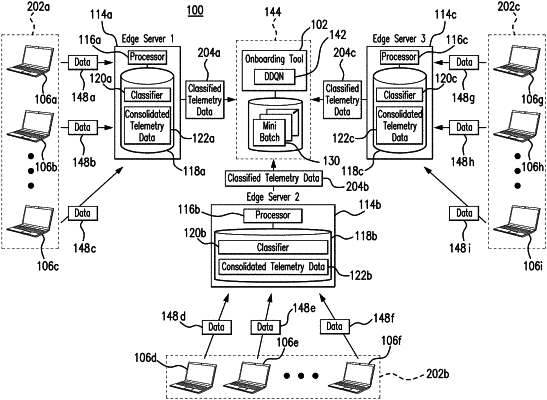| CPC G06F 9/5055 (2013.01) [G06F 9/5072 (2013.01); G06F 11/3438 (2013.01); G06F 11/3442 (2013.01); G06F 18/2178 (2023.01); G06F 2209/503 (2013.01)] | 20 Claims |

|
1. An system comprising:
a first server configured to:
receive a first set of telemetry data from a first device associated with a first user;
consolidate the first set of telemetry data, wherein consolidating the first set of telemetry data comprises averaging or calculating frequencies;
compress the consolidated first set of telemetry data, wherein compressing the consolidated first set of telemetry data comprises reducing a precision of the consolidated first set of telemetry data; and
generate, based on the compressed and consolidated first set of telemetry data, a set of information associated with the first user; and
a second server communicatively coupled to the first server, wherein the second server comprises:
a memory configured to store a deep Q reinforcement learning (DQN) algorithm configured, when executed by a hardware processor, to generate an action of a plurality of actions, based on a state of a plurality of states, wherein:
each action of the plurality of actions comprises a recommendation associated with a computational resource of a set of computational resources; and
each state of the plurality of states comprises at least an identification of a role of a plurality of roles within an enterprise; and
a hardware processor communicatively coupled to the memory, the hardware processor configured to:
receive the set of information associated with the first user, the set of information comprising:
an identification of a first role of the plurality of roles assigned to the first user; and
computational resource information associated with the first user, the computational resource information comprising information associated with a set of computational resources provisioned to the first user, wherein receiving the set of information associated with the first user comprises receiving a batch of information associated with a plurality of users comprising the first user, the batch of information comprising the set of information associated with the first user;
apply the DQN algorithm to a first state of the plurality of states, to generate a first action of the plurality of actions, the first state comprising an identification of the first role assigned to the first user, the first action comprising a first recommendation associated with a first computational resource of the set of computational resources;
in response to applying the DQN algorithm to the first state to generate the first action:
determine whether the first recommendation aligns with the computational resource information associated with the first user;
generate a reward value, wherein:
the reward value comprises a positive value, in response to determining that the first recommendation aligns with the computational resource information associated with the first user; and
the reward value comprises a negative value, in response to determining that the first recommendation does not align with the computational resource information associated with the first user; and
use the reward value to update the DQN algorithm;
generate a policy comprising at least the first recommendation, wherein the policy includes recommendations of hardware resources, virtual desktop resources, software resources, authentication protocols, and/or authorization levels to provision to a new user assigned to the first role; and
provision the new user assigned to the first role with at least the first computational resource according to the policy.
|